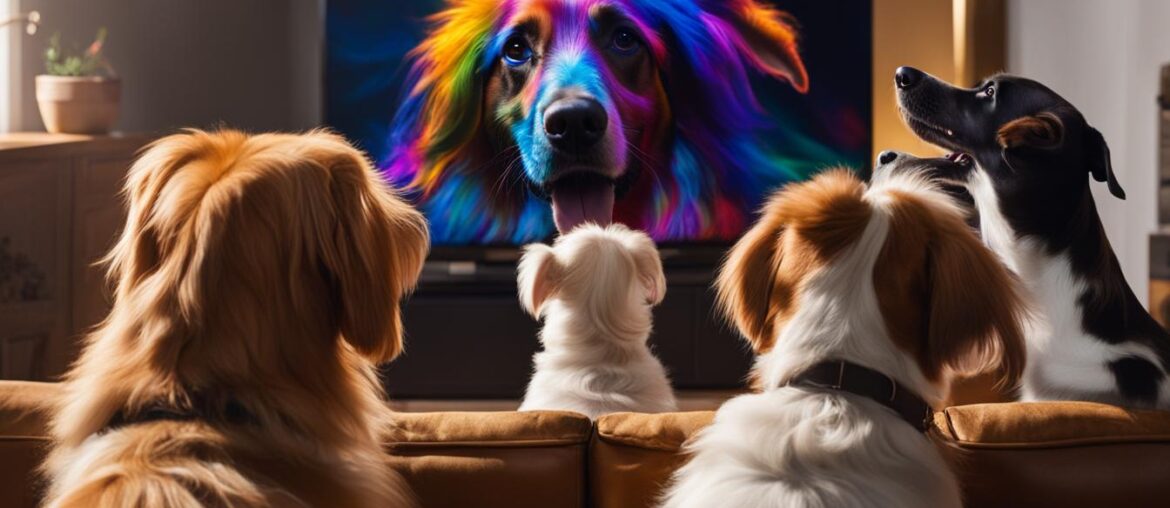If you’re a dog lover, you may have wondered whether dogs can see and understand TV. It’s a topic that has sparked debates among pet owners, but if you’ve ever seen your dog watching TV, you know that they are not only seeing it but also comprehending what they see.
Despite some limitations in color perception and visual acuity, dogs have the ability to see TV screens. Dogs have a remarkable ability to detect movement, which makes watching TV shows or videos possible for them. Although dogs see a limited range of colors, including yellow, blue, and gray tones, they can still enjoy watching TV and find it soothing.
Key Takeaways:
- Dogs can see and understand TV despite some differences in their vision compared to humans.
- Dogs have a keen ability to detect movement, which allows them to enjoy watching TV shows or videos.
- While dogs see a limited range of colors, they can still find TV entertaining and even comforting.
- Different dogs may have varying levels of interest in watching TV, influenced by factors such as their nature, nurture, and opportunity.
- TV can have benefits for dogs, providing mental stimulation and relaxation, especially for those who enjoy watching it.
Can Dogs See the TV Screen Clearly?
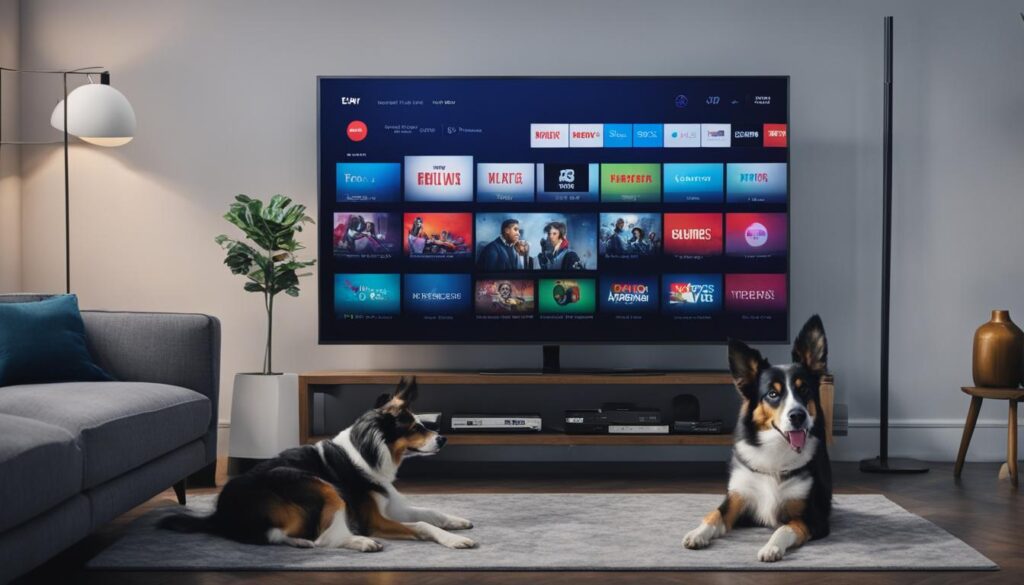
When it comes to visual perception, dogs have different abilities compared to humans. They have certain limitations in visual acuity and color perception. While dogs see the world differently, they can still enjoy watching TV with us.
To understand how dogs see the TV screen, it’s important to know that they have fewer color-detecting cones in their eyes compared to humans. This means that dogs see a limited color spectrum. They primarily see shades of yellow, blue, and gray. The vibrant colors that humans perceive may appear dull or muted to dogs.
Additionally, dogs have lower visual acuity, which refers to the sharpness and clarity of their vision. Dogs cannot see fine details on a TV screen as sharply as humans. The images may appear slightly blurry or pixelated to them.
However, despite these limitations, dogs have remarkable visual abilities when it comes to detecting motion and perceiving contrast. They excel in motion detection and can easily pick up on fast-moving objects or people on the TV screen. Dogs can also distinguish between different shades of gray, which allows them to perceive the contrast between light and dark areas in a scene.
The table below summarizes the visual capabilities of dogs compared to humans:
| Visual Aspect | Dogs | Humans |
|---|---|---|
| Color Perception | Limited color spectrum (primarily yellow, blue, and gray tones) | Full color spectrum |
| Visual Acuity | Lower visual acuity; cannot see fine details | Higher visual acuity; can see fine details |
| Motion Detection | Excellent; keen ability to detect and track movement | Good; but not as sensitive as dogs |
| Contrast Sensitivity | Superior; ability to perceive shades of gray and contrast | Good; but not as sharp as dogs |
Dogs may not see the TV screen as clearly as humans, but they can still enjoy the experience. The movement, sounds, and visual stimuli on the screen capture their attention and provide entertainment. Next, let’s explore what dogs actually see on the TV screen and how it captures their interest.
What Do Dogs See on TV?
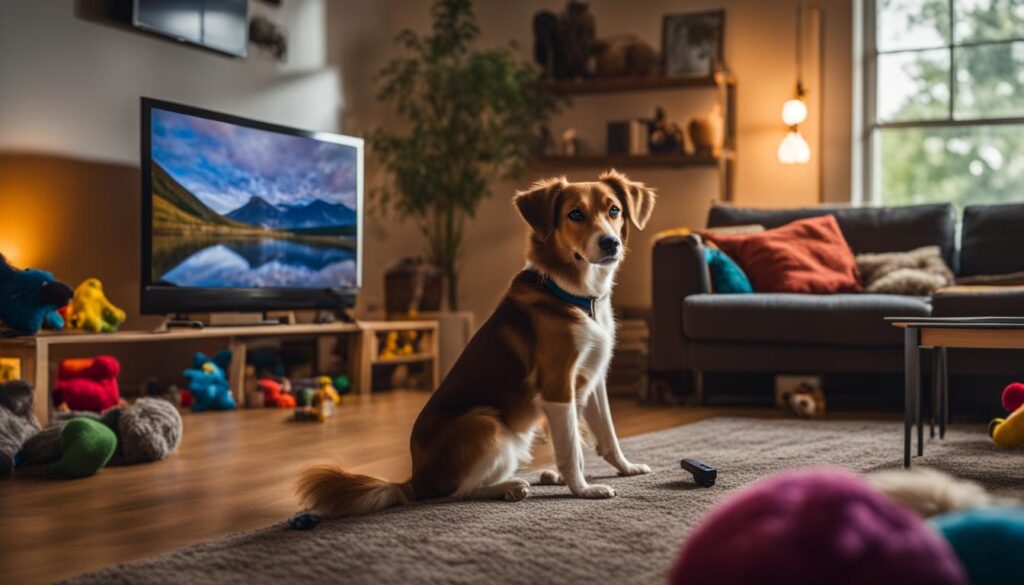
When dogs watch TV, they see images on the screen similar to what humans see, but with some differences. Dogs can recognize and respond to the movement on the TV screen, which captivates their attention. They are particularly interested in programs or videos that feature other animals or movements resembling prey. Dogs may also react to specific sounds and frequencies that align with their hearing range. While dogs may not see TV in the same way as humans, they can find entertainment in content that aligns with their sensory and instinctual inclinations.
To better understand what dogs see on TV, it’s important to consider their visual perception. Dogs have a different visual system compared to humans, with variations in color perception and visual acuity. Dogs see a more limited range of colors, primarily yellow, blue, and gray tones. They have fewer color-detecting cones in their eyes, which affect their ability to see subtle color variations.
However, dogs excel in motion detection and have superior contrast sensitivity. They can perceive the movement on a TV screen and distinguish between different shades of gray. This enhanced ability to detect movement makes TV shows and videos appealing to dogs, as they can track the action and engage with the visual stimuli.
It’s fascinating to observe how dogs react to TV shows and videos. They may bark, whine, or wag their tails in response to what they see on the screen. Some dogs may even try to interact with the images, pawing at the screen or moving their heads from side to side. This behavior showcases their engagement and fascination with the visual content.
While dogs may not fully comprehend the content of TV shows, they can still derive enjoyment from watching. The movement, colors within their visual spectrum, and animal-related stimuli all contribute to their interest. TV can provide dogs with entertainment, mental stimulation, and a form of relaxation. It can also serve as a bonding activity between dogs and their owners, as they can watch together and share the experience.
Favorite TV Shows and Programs for Dogs
Dogs have individual preferences when it comes to TV content. While they generally enjoy programs or videos featuring other animals or movements resembling prey, certain TV shows and programs have gained popularity among dog owners for their appeal to canine viewers. Here are some examples:
| TV Show/Program | Description |
|---|---|
| DOGS | A Netflix documentary series that explores the bond between dogs and humans, featuring heartwarming stories and beautiful cinematography. |
| Planet Earth | A nature documentary series that showcases stunning wildlife footage from across the globe, capturing the attention of both humans and dogs. |
| Squirrel and Bird-Watching Videos | Short online videos that simulate the experience of watching birds or squirrels, providing visual and auditory stimulation for dogs. |
These are just a few examples of TV shows and programs that dogs may find captivating. It’s important to recognize that not all dogs may exhibit interest in TV watching, and their preferences may vary. Some dogs may be more visually oriented and engaged, while others may find little interest in TV screens. The responses to TV stimuli are unique to each dog’s personality and temperament.
Why Do Some Dogs Watch TV While Others Don’t?

The interest of dogs in watching TV can vary among individuals. Some dogs actively watch TV, while others may not show any interest. The reasons behind this individual difference can be attributed to various factors. Factors that influence a dog’s interest in watching TV include their nature, nurture, and opportunity.
Some dogs may be more alert or visual, while certain dog breeds with high prey drives or guarding instincts may find watching TV exciting. For example, breeds like Border Collies, Terriers, and German Shepherds, known for their high energy and heightened senses, may show more interest in TV than breeds that have a calmer disposition.
Dogs that have never had the opportunity to watch TV may not know what to do when given the chance. Exposure to TV from a young age can make dogs more familiar with the concept of screens and moving images, increasing their likelihood of watching TV.
It’s important to note that even if a dog doesn’t watch TV, they might still enjoy the noise of the TV or find comfort in it. The sounds and voices coming from the TV can provide a sense of company and reduce feelings of loneliness for some dogs.
Factors Influencing Dogs’ Interest in TV
- Nature of the dog (alertness, visual orientation)
- Breed characteristics (prey drive, guarding instincts)
- Exposure to TV from a young age
- Individual preferences and behavior
| Factors | Influence on Dogs’ TV Watching |
|---|---|
| Nature of the dog | Some dogs are naturally more inclined to be visually oriented and curious, which can make them more interested in watching TV. |
| Breed characteristics | Dogs breeds with high prey drives or guarding instincts may find TV stimulating and exciting. |
| Exposure to TV from a young age | Dogs that have been exposed to TV as puppies are more likely to understand and enjoy watching TV. |
| Individual preferences and behavior | Each dog has its own unique preferences and behaviors, which can impact their interest in TV watching. |
Can TV Benefits Dogs?
TV can have numerous benefits for dogs, especially for those who enjoy watching it. It can provide mental stimulation and serve as a source of relaxation, helping to keep them occupied and calm. Dogs, much like humans, can be entertained and captivated by the sounds and images they perceive on the TV screen. Watching TV can offer a unique form of mental engagement for dogs, keeping their minds active and preventing boredom.
For dogs that experience anxiety or have a tendency to become bored easily, TV can be a valuable tool in providing a sense of comfort and distraction. The visual and auditory stimuli from the TV can help alleviate anxiety symptoms and redirect their focus away from external stressors. It can create a soothing environment for dogs, making them feel more at ease when left alone or during stressful situations.
However, it’s important to understand that not all dogs will find TV enjoyable or calming. Just like humans, dogs have individual preferences and reactions to various stimuli. Some dogs may show no interest in TV, while others may become overly excited or agitated. It’s crucial to monitor a dog’s behavior and adjust accordingly to ensure their well-being.
While TV can be a beneficial source of mental stimulation and relaxation for dogs, it is advisable to explore other forms of mental enrichment as well. Interactive toys, puzzles, and engaging activities tailored to a dog’s breed and preferences can provide additional outlets for mental stimulation and prevent boredom. A balanced approach that combines TV time with other forms of mental and physical exercise is key to ensuring a happy and healthy dog.
In conclusion, TV can indeed benefit dogs by offering mental stimulation, relaxation, and a sense of companionship. It can be particularly helpful for dogs prone to boredom or anxiety. However, it’s vital to consider each dog’s unique needs and preferences and to supplement TV viewing with other forms of mental enrichment and physical exercise.
| Benefits of TV for Dogs | TV as a Solution for Dog Boredom and Anxiety | TV as a Source of Relaxation for Dogs | Mental Stimulation for Dogs through TV |
|---|---|---|---|
| Provides mental stimulation | Alleviates boredom and anxiety | Creates a soothing environment | Keeps dogs mentally engaged |
| Captivates attention and focus | Offers a sense of comfort and distraction | Reduces stress and anxiety symptoms | Prevents mental fatigue and boredom |
| Entertains and occupies dogs | Redirects focus away from external stressors | Enhances relaxation and calmness | Improves cognitive abilities and problem-solving skills |
Special TV Programs and Content for Dogs
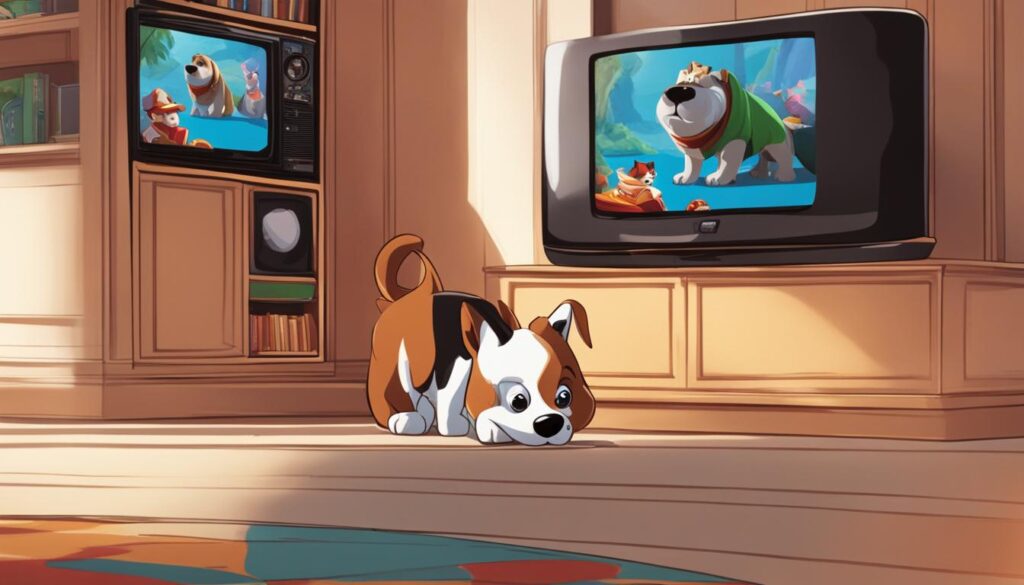
When it comes to TV programs and content, dogs have their own dedicated options. One notable service is DOGTV, a streaming platform specifically designed for dogs and their owners. DOGTV offers a range of programs categorized into relaxation, stimulation, and exposure, all tailored to cater to dogs’ specific needs. Through carefully crafted content, DOGTV aims to reduce stress, provide mental and visual stimulation, and help dogs become more comfortable in their environment.
Aside from DOGTV, content creators on platforms like YouTube have also recognized the demand for dog-friendly shows and created videos specifically tailored to dogs’ interests. These videos may include nature documentaries showcasing animals and calming visuals that appeal to dogs’ visual perception and sensory preferences.
By providing specialized TV programs and content, these platforms and creators are working to enhance dogs’ viewing experience and cater to their unique needs. Whether it’s through DOGTV or curated YouTube content, dog owners now have access to a variety of options to feed their furry friends’ entertainment needs.
Do Intelligent Dogs Watch TV More?
When it comes to dogs watching TV, there isn’t much evidence to suggest that intelligence plays a significant role. Whether a dog is intelligent or not, their interest in watching TV is more likely influenced by factors such as their natural prey drives, alertness, and curiosity about other animals or people.
While intelligence may play a role in shaping a dog’s behavior and learning abilities, it doesn’t necessarily determine their inclination to watch TV. Dogs with different levels of intelligence are equally capable of enjoying and engaging with visual stimuli on the screen, as long as they have an interest in it.
The individual personality of a dog also plays a part in their reactions to TV. Some dogs may be more visually oriented and find entertainment in watching TV, while others may not show as much interest. It’s important to consider that a dog’s preferences and behaviors can vary widely, regardless of their intelligence.
Ultimately, the ability and desire to watch TV is more closely related to factors such as the specific nature of the dog, their upbringing, and their exposure to TV. It’s fascinating to observe how dogs, regardless of their intelligence, can find enjoyment and engagement in visual media.
Can Cats Also Watch TV?
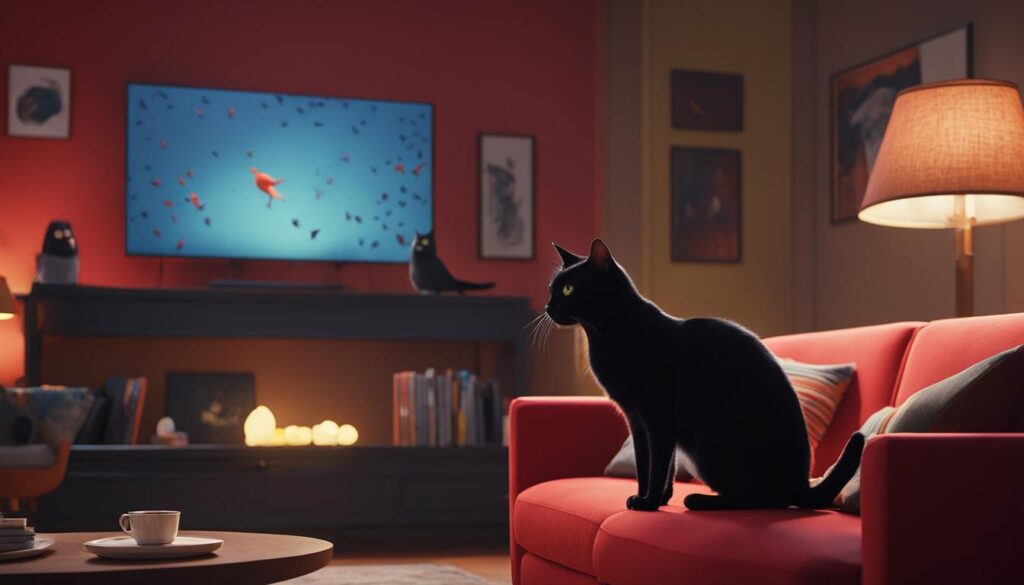
Cats can also watch TV, and some of them enjoy it as much as dogs do. However, cats may exhibit different behaviors while watching TV compared to dogs. Cats are more prone to try to catch or play with images on the screen, which is less common in dogs. Like dogs, cats are attracted to movement and certain sounds on the TV screen. They may find shows or content featuring other animals or movements captivating.
Do Dogs Prefer to Watch TV Alone?
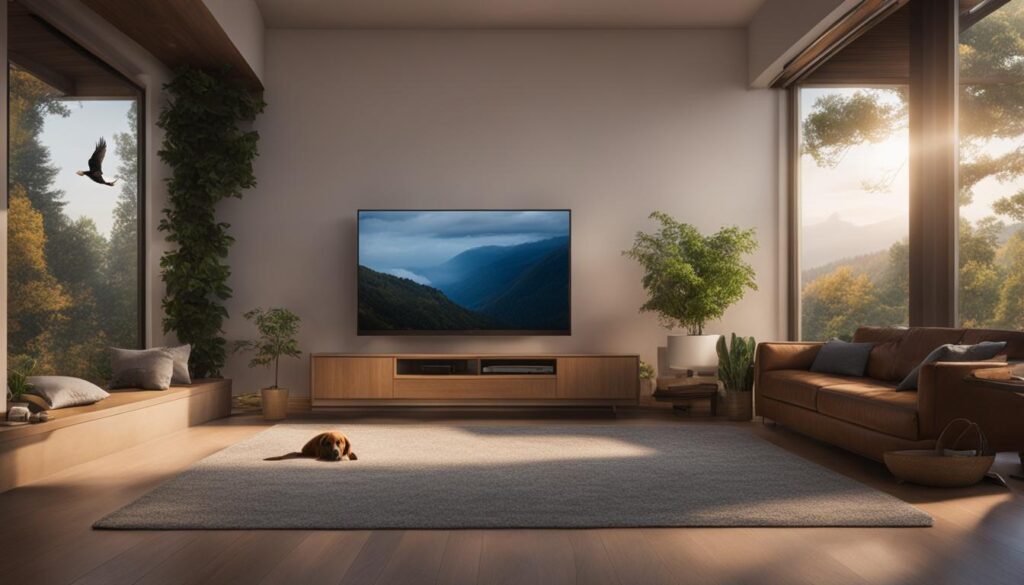
Some dogs enjoy watching TV when they are alone. Leaving the TV on while the owner is away can help dogs relax and cope with separation anxiety. The actions and sounds on the screen can provide a sense of companionship and distraction. Dogs with separation anxiety might find comfort in watching TV, as it helps them forget about their loneliness. However, not all dogs may respond positively to TV when alone, and it’s important to consider each dog’s individual needs and preferences.
| Pros | Cons |
|---|---|
| Can help dogs relax and cope with separation anxiety | Not all dogs may respond positively to TV when alone |
| Provides a sense of companionship and distraction | Depends on each dog’s individual needs and preferences |
| Helps dogs forget about their loneliness |
Wrapping Up
Dogs have the ability to see and watch TV, despite having different visual capabilities than humans. While dogs may have limitations in color perception and visual acuity, their heightened senses of movement detection and contrast sensitivity allow them to enjoy TV viewing. Although not all dogs may be interested in watching TV, for those that are, it can provide mental stimulation, relaxation, and even help alleviate separation anxiety.
When it comes to TV content, dogs have their unique preferences, with a strong focus on movements and certain sounds. Understanding how dogs perceive and engage with TV can enhance their viewing experience and strengthen the bond between dogs and their owners. By catering to their sensory inclinations, dog owners can ensure that their furry companions have an enriching and enjoyable TV-watching experience.
In summary, while dogs may not see TV in the same way as humans, they are capable of watching and deriving entertainment from it. Canine vision and TV viewing go hand in hand, providing dogs with an opportunity for mental stimulation, relaxation, and a sense of companionship. So, the next time you settle in to watch your favorite show or movie, consider inviting your four-legged friend to join in on the TV-watching experience.
FAQ
Can Dogs See the TV Screen Clearly?
Yes, dogs can see TV screens, although they have limitations in visual acuity and color perception compared to humans. Dogs have fewer color-detecting cones in their eyes and primarily see shades of yellow, blue, and gray. However, they excel in motion detection and contrast sensitivity, allowing them to perceive movement on a TV screen and distinguish between different shades of gray.
What Do Dogs See on TV?
When dogs watch TV, they see images on the screen similar to what humans see, although with differences in color perception and visual acuity. Dogs are particularly interested in programs or videos that feature other animals or movements resembling prey. They can recognize and respond to the movement on the TV screen, captivated by the motion and certain sounds aligned with their hearing range.
Why Do Some Dogs Watch TV While Others Don’t?
Dogs’ interest in watching TV can vary among individuals. Factors such as their nature, nurture, and opportunity to watch TV can influence their level of interest. Some dogs may be more alert or visual, while certain dog breeds with high prey drives or guarding instincts may find watching TV exciting. Dogs that have never had the opportunity to watch TV may not know what to do when given the chance. Additionally, certain dogs may find comfort or entertainment in the noise of the TV, even if they don’t actively watch the screen.
Can TV Benefit Dogs?
Yes, TV can have benefits for dogs, especially those who enjoy watching it. TV can provide mental stimulation through the sounds and images they perceive, helping to keep them occupied and relaxed. Watching TV can also be a source of relaxation, particularly for dogs experiencing boredom or anxiety. However, it’s important to consider each dog’s individual preferences and reactions to TV, as not all dogs will find it enjoyable or calming. Exploring other forms of mental stimulation and relaxation, such as interactive toys and puzzles, is also beneficial for dogs.
Are There Special TV Programs and Content for Dogs?
Yes, there are TV programs and content specifically designed for dogs. For example, DOGTV is a unique streaming service that features shows designed for dogs and their owners. They offer programs categorized into relaxation, stimulation, and exposure, aiming to reduce stress, provide stimulation, and help dogs feel more comfortable in their environment. Additionally, content creators on YouTube and across the internet have created videos tailored for dogs, such as nature documentaries and calming visuals. These programs and content cater to the specific interests and sensory preferences of dogs.
Do Intelligent Dogs Watch TV More?
The interest of dogs in watching TV is not significantly influenced by their level of intelligence. Dogs that watch TV are more likely to be motivated by factors such as their natural prey drives, alertness, and interest in watching people or other animals. The individual personality of a dog also plays a role in their reactions to TV. Both intelligent and less intelligent dogs are equally capable of watching and enjoying TV, as long as they have an interest in visual stimuli.
Can Cats Also Watch TV?
Yes, cats can also watch TV and some of them enjoy it as much as dogs do. However, cats may exhibit different behaviors while watching TV compared to dogs. Cats are more prone to try to catch or play with images on the screen, which is less common in dogs. Like dogs, cats are attracted to movement and certain sounds on the TV screen, finding shows or content featuring other animals or movements captivating.
Do Dogs Prefer to Watch TV Alone?
Some dogs enjoy watching TV when they are alone. Leaving the TV on while the owner is away can help dogs relax and cope with separation anxiety. The actions and sounds on the screen can provide a sense of companionship and distraction, helping dogs forget about their loneliness. However, not all dogs may respond positively to TV when alone, and it’s important to consider each dog’s individual needs and preferences.


